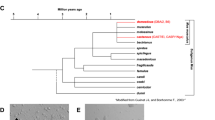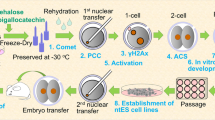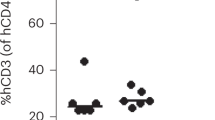Abstract
Cryopreservation of embryos or germ cells is commonly used in animal facilities to archive strains of genetically modified mice, both to reduce facility space usage and to protect the strains from losses due to environmental disaster, genetic drift, disease outbreak or breeding failure. The authors' institution maintains a cryopreservation repository for various mouse strains, including immunocompromised mice. When the institution experienced a breeding failure with one strain of immunocompromised mice (NOD.CB17–Prkdcscid/NcrCrl), the authors successfully re-established a breeding colony of the mice by reviving frozen embryos from the institution's cryopreservation repository. They confirmed that the recovered progeny lacked T and B cells. The authors conclude that a breeding colony of immunocompromised mice can be successfully re-established from a minimal number of cryopreserved embryos.
This is a preview of subscription content, access via your institution
Access options
Subscribe to this journal
We are sorry, but there is no personal subscription option available for your country.
Buy this article
- Purchase on Springer Link
- Instant access to full article PDF
Prices may be subject to local taxes which are calculated during checkout


Similar content being viewed by others
References
Pomeroy, K.O. Cryopreservation of transgenic mice. Genet. Anal. Tech. Appl. 8, 95–101 (1991).
Wayss, K.W., Michaela, K. & Johannes, S. Cryopreservation of transgenic mouse embryos—an eight year's experience. J. Exp. Anim. Sci. 43, 69–85 (2005).
Landel, P. Archiving mouse strain by cryopreservation. Lab Anim. (NY) 34, 50–57 (2005).
Whittingham, D., Leibo, S. & Mazur, P. Survival of mouse embryos frozen to −196 degrees and −269 degrees. Current. Sci. 178, 411–414 (1972).
Mello, M.R.B. et al. Cryopreservation of mouse morulae through different methods: slow-freezing, vitrification and quick-freezing. Braz. J. Vet. Res. Anim. Sci. 38, 160–164 (2001).
Thorat, R.A. & Ingle, A.D. An attempt of cryopreservation of mouse embryos at the ACTREC laboratory animal facility in India. Exp. Anim. 61, 139–145 (2012).
Surgical procedures in Manipulating the Mouse Embryo: A Laboratory Manual (eds. Nagy, A., Gertsenstein, M., Vintersten, K. & Behringer, R.) 3rd edn. 258–260 (Cold Spring Harbor Press, New York, 2002).
Lai, L., Alaverdi, N., Maltais, L. & Morse, H.C. Mouse cell surface antigens: nomenclature and immunophenotyping. J. Immunol. 160, 3861–3868 (1998).
Murray, S., Subramanian, S., Bourdette, D.N. & Jones, R. Simplified method of identifying severe combined immunodeficient (SCID) mice versus non-SCID mice by flow cytometric analysis of peripheral blood. Cytometry 32, 274–279 (1998).
Pinchuk, L. & Filipov, N. Differential effects of age on circulating and splenic leukocyte populations in C57BL/6 and BALB/c male mice. Immun. Ageing 5, 1 (2008).
Institute of Laboratory Animal Research. Guide for the Care and Use of Laboratory Animals 8th edn. (National Academies Press, Washington, DC, 2011).
Renard, J.P. & Babinet, C. High survival of mouse embryos after rapid freezing and thawing inside plastic straws with 1-2 propanediol as cryoprotectant. J. Exp. Zool. 230, 443–448 (1984).
Petkova, S.B. et al. Genetic influence on immune phenotype revealed strain-specific variations in peripheral blood lineages. Physiol. Genomics 34, 304–314 (2008).
Mobraaten, L.E. Mouse embryo cryobanking. J. In Vitro Fert. Embryo Transf. 3, 28–32 (1986).
Acknowledgements
We thank Dr. S.V. Chiplunkar, Mrs. Rekha Gaur and Ms. Shamal Vetale for providing technical support.
Author information
Authors and Affiliations
Corresponding author
Ethics declarations
Competing interests
The authors declare no competing financial interests.
Rights and permissions
About this article
Cite this article
Thorat, R., Ahire, S. & Ingle, A. Re-establishment of a breeding colony of immunocompromised mice through revival of cryopreserved embryos. Lab Anim 42, 131–134 (2013). https://doi.org/10.1038/laban.191
Received:
Accepted:
Published:
Issue Date:
DOI: https://doi.org/10.1038/laban.191



